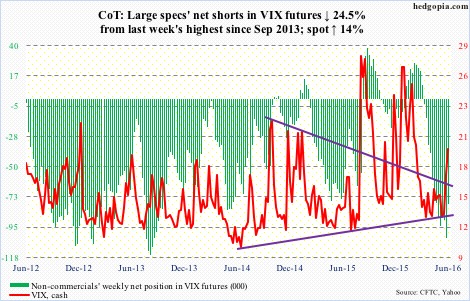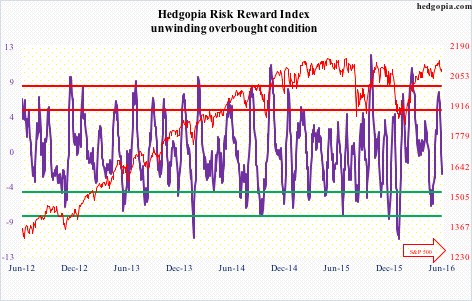The following are futures positions of non-commercials as of June 14, 2016. Change is week-over-week.
10-year note: In Godfather III, Michael Corleone famously says: “Just when I thought I was out, they pull me back in.”
Given the circumstances, this might as well be uttered by the Fed.
In 2014, the economic recovery was in its fifth year. Most data were firm. In the second half, capacity utilization persistently stayed in the 78-percent range. Non-farm payroll averaged a monthly addition of 251,000. Home sales were trending higher. And orders for non-defense capital goods ex-aircraft jumped to a seasonally adjusted annual rate of $70.7 billion in September.
Hindsight is always 20/20, and no one said the Fed’s job was easy. But it decided to wait. Inflation was still benign, and wages had not yet picked up steam. Going by history, there was room for things to get hotter.
But this cycle has proven to be atypical in many respects.
Soon, data began to soften. Capacity utilization peaked in September 2014, as did non-defense capital goods ex-aircraft. Monthly addition in non-farm payroll slowed to an average 229,000 in 2015, although the unemployment rate continued lower, thanks to shrinkage in the labor force.
Pretty soon, the window of opportunity to hike got narrower.
Now, the Fed genuinely sounds like it would like to push up rates. If nothing else to fill its empty traditional monetary tool box with arrows. In fact, it did hike last December, taking the fed funds target rate to 0.25 percent-0.50 percent. This was a first hike in nearly 10 years. Nonetheless, economic data have continued to soften since.
In this week’s FOMC projection, estimate of U.S. growth this year was trimmed to two percent from 2.2 percent. As much as the Fed would like to get off the zero bound, soft economic data keep pulling it back in. A la Michael Corleone.
Currently net long 45.1k, up 29.9k.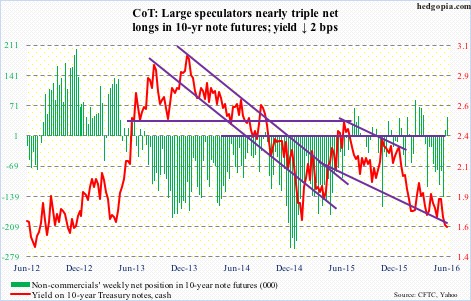
30-year bond: Major economic releases next week are as follows. It is a relatively light week.
On Wednesday, May’s existing home sales are published. April sold a seasonally adjusted annual rate of 5.45 million units, just a stone’s throw away from last July’s 5.48 million units – the highest since February 2007. From this perspective, sales have essentially gone sideways for nearly a year.
New home sales for May come out on Thursday. April surged 16.6 percent to a seasonally adjusted annual rate of 619,000 units – the highest since January 2008 – breaking out of a 15-month range.
Friday brings durable goods (May, advance report) and the University of Michigan’s consumer sentiment (June, final).
In April, orders for non-defense capital goods ex-aircraft – proxy for business capex – fell 0.8 percent m/m and five percent y/y to a seasonally adjusted annual rate of $$62.4 billion. This was a sixth straight y/y decline, and 15th out of the last 16. Orders peaked at $70.7 billion in September 2014.
In consumer sentiment, June’s preliminary count was 94.3, down four-tenths of a percentage point m/m. The cycle high was reached in January last year at 98.1 – an 11-year high.
Three FOMC members have scheduled appearances, including Ms. Yellen, who speaks twice – at 10AM each on Tuesday and Wednesday.
Currently net long 77.3k, down 13.5k.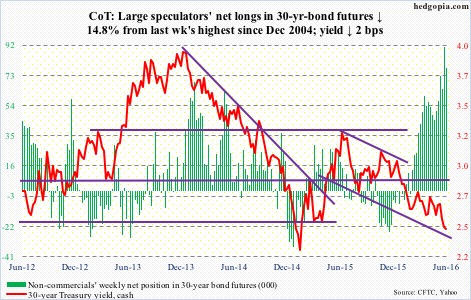
Crude oil: Oil bears tried to further build on last week’s ugly reversal on spot West Texas Intermediate crude. Oil at one point was down 5.1 percent through Friday’s intra-day low, before it strongly reversed, ending the week flat.
Early in the week, technicals ruled, as traders ignored good news on the inventory front.
For the week to June 10th, crude inventory declined 933,000 barrels to 531.5 million barrels. Inventory is now down 11.8 million barrels from the April 29th high of 543.4 million barrels, which was the highest since the all-time high 545.2 million barrels in October 1929.
Gasoline stocks fell by another 2.6 million barrels to 237 million barrels. Inventory is now down 21.7 million barrels from the February 12th high of 258.7 million barrels.
Crude production fell, too, by 29,000 barrels per day to 8.72 million b/d. Production peaked at 9.61 mb/d in the June 5th week last year.
Also under pressure were crude imports, down 83,000 b/d to 7.62 mb/d.
On the negative side, distillate inventory rose 786,000 barrels to 152.2 million barrels. And refinery utilization dropped seven-tenths of a point to 90.2 percent.
Crude remains overbought on the weekly chart, and shed five points from the June 9th high before approaching the rising 50-day moving average, which was vigorously defended on Friday.
There is a tremendous push and pull going on between bulls and bears. Last week produced an inverted hammer, this week a hammer.
Currently net long 313.9k, down 16k.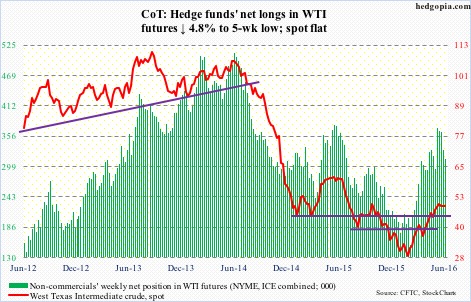
E-mini S&P 500: Through Thursday’s intra-day low, the S&P 500 was down 2.2 percent, but rallied back to end the week down only 1.2 percent.
Having lost the now sharply declining 10-day moving average last Friday, this week it also lost the 20- and 50-day. It has been on and around the latter the past four sessions.
Despite the sharp spike in volatility in recent sessions, the index was spared from a sharp sell-off. Kudos to the bulls! From the June 8th high through the Thursday hammer low, it lost 3.3 percent, and is only 3.1 percent from the all-time high 2134.72 of May last year.
Thursday’s action is encouraging, but for the index to go attack that resistance again, flows need to cooperate. On this front, the record is spotty. In the week ended Wednesday, SPY, the SPDR S&P 500 ETF, attracted $1.4 billion. This comes on the heels of outflows of $71.7 million in the prior week (courtesy of ETF.com).
However, U.S.-based equity funds continue to lose funds, having lost $3.4 billion in the week ended Wednesday. This was a seventh straight weekly withdrawal. For reference, since the week ended February 10th, these funds have lost north of $47 billion (courtesy of Lipper).
Further, global investors continue to flee U.S. stocks. In April, they sold $2.8 billion worth, and $30 billion in February-April combined. Using a 12-month rolling total, April saw sales of $135.6 billion, not too far away from a record $138.9 billion this February. The last time this metric was positive was February last year.
Bulls sure hope this changes.
Currently net short 31.8k, down 76.2k.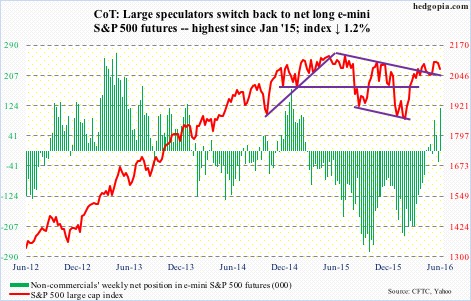
Euro: Eurozone industrial production rebounded in April, rising 1.1 percent. This comes on the heels of back-to-back decline of 0.7 percent in March and 1.2 percent in February.
In the meantime, Eurozone consumer prices fell 0.1 percent y/y in May, but slower than the 0.2-percent decline in April. Despite oodles of QE (quantitative easing) money sloshing around, inflation is missing in action.
The euro acted as if it did not know which data to react to, trading within a relatively wide range – 113 on the high and 111.3 on the low. Thursday’s weekly low nearly tested the 200-day moving average (111.09), which is flat to slightly declining. And on Wednesday, the currency was just about repelled by the 50-day moving average, which is slightly dropping. The euro is right underneath that average, and could go either way near term, with a slight upward bias.
Currently net long 118.2k, up 150k.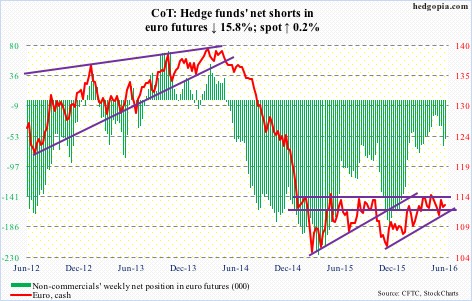
Gold: After two weeks of strong price action during which it rallied five percent, spot gold rallied another two percent this week, although it was unable to hang on to all the gains, with the metal up as much as 3.3 percent before a strong intra-day reversal on Thursday.
Thursday’s intra-day high of $1318.9 was the highest since August 2014.
Gold’s rally in the first three sessions was fully supported by inflows. In the week ended Wednesday, GLD, the SPDR gold ETF, attracted $714 million, on the heels of $417 million in inflows in the prior week (courtesy of ETF.com).
Most importantly, non-commercials pushed on the accelerator this week. Ahead of the Brexit vote, net longs are the highest ever.
Currently net long 279.9k, up 51.2k.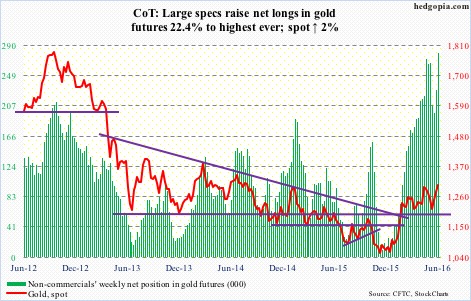
Nasdaq 100 index (mini): If traders were in a risk-on mode in the second half last month, they were definitely not using the Nasdaq 100 for that purpose. The June 6th high could never surpass the April 19th high. The good thing is, the May lows stand, so we are not looking at ‘lower highs, lower lows’.
That said, on Thursday the Nasdaq 100 substantially breached the 200-day moving average before recapturing with a strong reversal, and losing it again on Friday.
Flows continue to be a suspect, and need to improve. In the week ended Wednesday, QQQ, the PowerShares Nasdaq 100 ETF, lost $97.7 million, following inflows of $4.6 million in the prior week (courtesy of ETF.com).
Non-commercials have been aggressively adding to net longs, but have not paid off, with the index down three percent in the past two weeks.
Currently net long 83.2k, up 20.5k.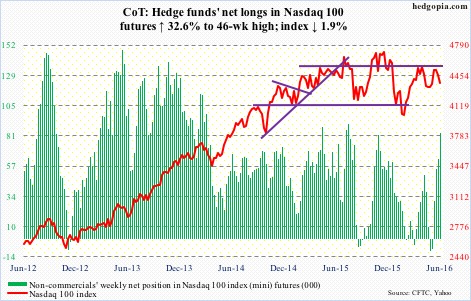
Russell 2000 mini-index: Talk about extreme indecision in the market.
Last week produced a weekly gravestone doji on the Russell 2000. By Thursday’s intra-day low this week, it was down 2.7 percent, but the session pulled off a strong reversal, hammering out a dragonfly doji right on the 50-day moving average.
Granted these are two different timeframes, but here is one way to look at this.
Weekly conditions remain overbought, and may take time for unwinding. On the other hand, the desire to own near an important average probably implies bull’s determination not to give up easy, and can bode well near term.
Provided, of course, flows cooperate. In the week ended Wednesday, IWM, the iShares Russell 2000 ETF, lost $108 million, following inflows of $14.2 million in the prior week (courtesy of ETF.com).
Currently net short 15.5k, down 9.6k.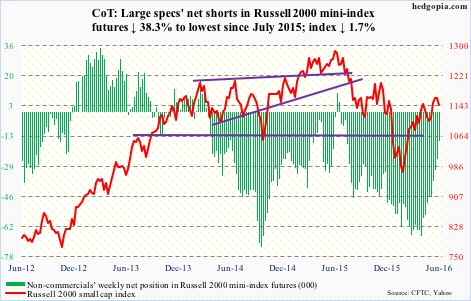
US Dollar Index: Hugged the 50-day moving average in all five sessions this week. Thursday was a long-legged doji session, with a high of 95.54 and a low of 94.26 – very volatile. Currency traders are probably struggling to decide which way to position ahead of the Brexit vote next week. As is the case with the euro, the dollar index could go either way near term, with a slight downward bias.
Non-commercials continue to cut back net longs, with holdings at two-year lows.
Currently net long 4.7k, down 5.1k.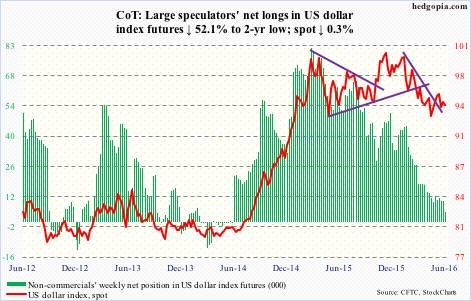
VIX: Quite a contango crash!
Back on May 27th, the VXST (nine days)-VIX (30 days)-VXV (90 days)-VXMT (six months) volatility curve was in steep contango, with the spread between VXST and VXMT negative 8.95 points. Fast forward to this Thursday, the spread shifted to positive 3.26 points.
The VIX-to-VXV ratio, using intra-day highs jumped to 0.973 on Thursday and 0.972 on Tuesday, pretty much unwinding the oversold condition it was in.
Further, spot VIX rallied north of 10 points in mere eight sessions, and Thursday may have flashed a spike reversal signal. With the caveat that next week is the Brexit vote, if it is a spike reversal, odds are decent that in the right circumstances premium can come out of spot VIX fast.

